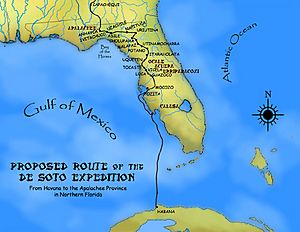Mocoso facts for kids
Mocoso (also called Mocoço) was the name of a Native American group in Florida during the 1500s. It was also the name of their main town and their chief. They lived on the east side of Tampa Bay, near the Alafia River. Later, in the 1600s, another village named Mocoso existed in a different area called Acuera. This second Mocoso village was part of the Timucua people. Experts believe that both groups spoke the Timucua language.
Contents
Who Were the Mocoso People?
The Mocoso people who lived near Tampa Bay were part of the Safety Harbor culture. They were among the first Native American groups in Florida to meet European explorers. This happened when the Narváez expedition arrived in 1528 and the de Soto expedition came in 1539.
A Spanish explorer named Hernando de Escalante Fontaneda was held captive by different tribes in Florida from about 1549 to 1566. He said that Mocoso was its "own kingdom." This meant it was not part of the powerful Calusa group. However, the people who wrote about the de Soto expedition said that Mocoso was under the rule of an inland chief named Paracoxi or Urriparacoxi. This chief lived in a village with the same name. "Paracoxi" was a special title for leaders among some of the Eastern Timucua groups.
Meeting the Spanish Explorers
The de Soto expedition found a Spanish man named Juan Ortiz living with the Mocoso. Ortiz had been captured earlier by the Uzita tribe while he was looking for the lost Narváez expedition. He later escaped and found safety with the Mocoso. Ortiz learned the Timucua language while living with them. This was very helpful for de Soto, as Ortiz became his interpreter. He helped de Soto talk to the Timucuan-speaking groups as the expedition traveled towards Apalachee.
Mocoso Customs and Language
The Mocoso people had unique customs. They painted their bodies red and wore feathers in their hair.
Historians believe the Mocoso spoke a special version, or dialect, of the Timucua language. This is because their language was different from their neighbors, the Uzita, Tocobago, and Calusa. Also, like the Timucua, the Mocoso tattooed their bodies. There are no records of other tribes around Tampa Bay doing this. Since Juan Ortiz lived with the Mocoso and learned Timucua, it suggests that Timucua was their language. Plus, their chief had a Timucuan name, which also points to them being Timucuan speakers.
Later History of Mocoso
In 1614, the Spanish governor of Florida reported a big attack. About 300 war canoes from the Calusa tribe attacked two towns in the Mocoso area near Tampa Bay. Around 500 people were killed because these towns were allies of the Spanish.
Later, in the 1600s, a village named Mocoso was recorded in the Acuera province. A person from this Mocoso village, Diego Salvador, became a royal interpreter in Apalachee. He could speak Spanish, Timucua, and Apalachee. He also served as a sergeant major in the Spanish Army and might have had close ties with the Spanish governor of Florida.
Some historians think that the Mocoso people near Tampa Bay might have made other tribes angry by helping the de Soto expedition. This could have forced them to move inland, eventually ending up in Acuera. It's also thought that Diego Salvador's important position might have been a reward for the help an ancestor gave to de Soto.


